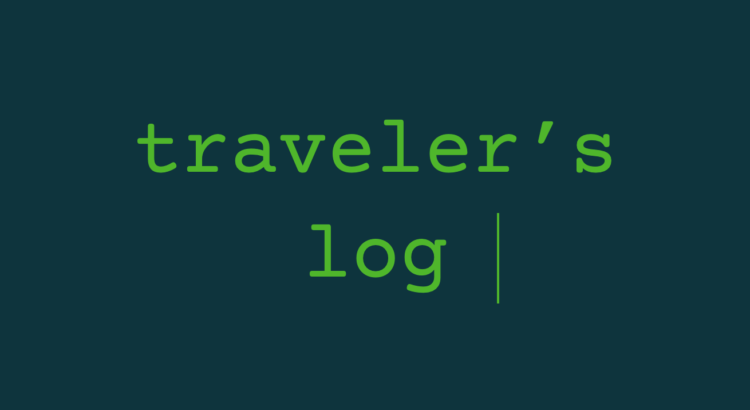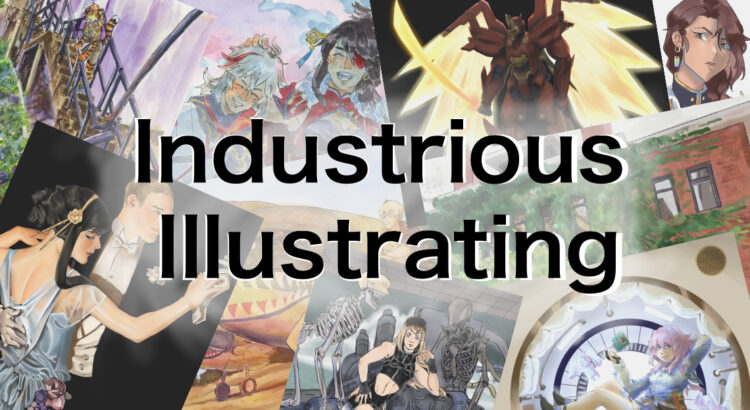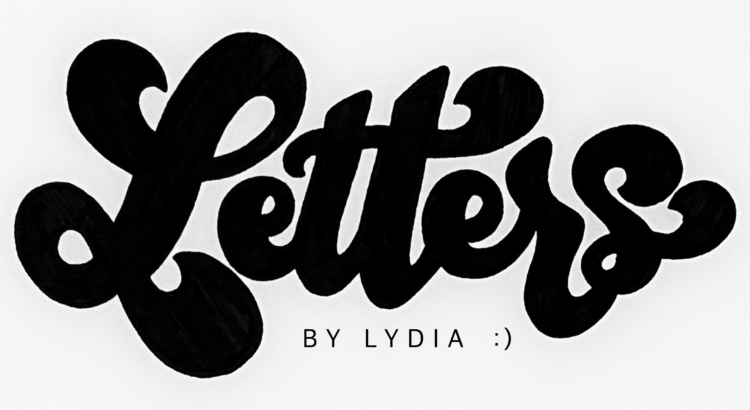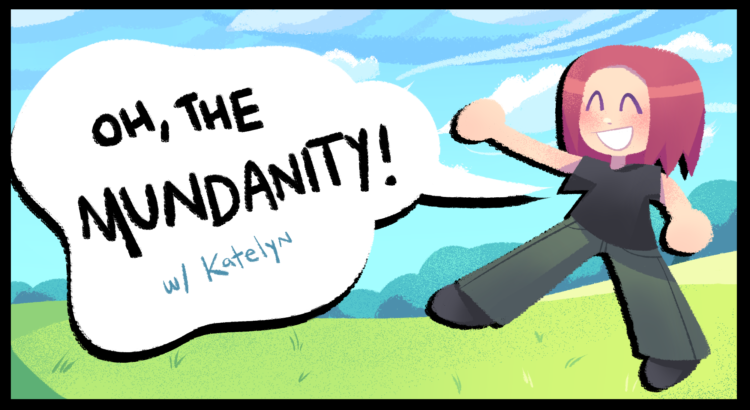Welcome to another week y’all! Today I thought I’d give you all a little intro on brush lettering 101.
To start, what exactly is brush lettering? Just what it sounds like. It’s handlettering, but specifically with brush pens. If you’re new here, a brush pen is basically a marker with a brush tip, which handletterers use when they want to get line variation in their letters. I would say brush lettering is probably the most common type of lettering, but it definitely has a bit of a learning curve.
The key to it is in learning the different kinds of strokes, or lines.  The basics all come down to upstrokes and downstrokes. Upstrokes are thin lines that use just the very tip of the brush pen, and they start from the bottom and go in an upwards direction (as the name implies). Downstrokes, again, what a shocker, start at the top and go in a downward motion. These are thicker lines because they involve using more pressure on the pen. I demonstrated this with the pictures below, using my favorite brush pens, Karin brushmarker pros.
The basics all come down to upstrokes and downstrokes. Upstrokes are thin lines that use just the very tip of the brush pen, and they start from the bottom and go in an upwards direction (as the name implies). Downstrokes, again, what a shocker, start at the top and go in a downward motion. These are thicker lines because they involve using more pressure on the pen. I demonstrated this with the pictures below, using my favorite brush pens, Karin brushmarker pros.

 Once you get these basic strokes down, you can start experimenting with more complicated strokes. I’m not sure who originally came up with this set of strokes to practice, but I know I’ve seen @thehappyevercrafter and @ensigninsights use these on Instagram (highly recommend their accounts, especially for beginners!). In any case, these are essentially the core kinds of strokes or lines you’ll need to be comfortable making, because they appear in a lot of letters.
Once you get these basic strokes down, you can start experimenting with more complicated strokes. I’m not sure who originally came up with this set of strokes to practice, but I know I’ve seen @thehappyevercrafter and @ensigninsights use these on Instagram (highly recommend their accounts, especially for beginners!). In any case, these are essentially the core kinds of strokes or lines you’ll need to be comfortable making, because they appear in a lot of letters.

They can definitely be a little awkward at first, but once you get the hang of them, lettering with brush pens will be soooo much easier! In the picture I included here, I drew the strokes in the top line and added in a circle so you know where to start, and then arrows so you know which direction you’re drawing in. In the second line, I drew the same strokes again just so you can see them a little more clearly. As you can see, all the upstrokes are thin and all the downstrokes are thicker lines.
So how do these actually show up in lettering? Let’s look at some letters so you can see 🙂
 Here’s your basic lower-case, cursive “a”. To make this, you actually have to use two strokes (shown in the picture), meaning you pick up your pen once in between. For the first stroke, the oval-ish shape, you start where I put the little 1 in a circle. From there, you start with an upstroke, then transition into a downstroke, and finish off with another upstroke that connects to the first. Then, you pick up your pen, and begin stroke two! This one is a lot easier–start at the same height as the top of your oval, and just go straight down, then kind of flick your pen back up for that final upstroke. I’m not going to guide you through every letter because we’d be here forever, but I did include a little sheet I drew of all the letters and some guiding arrows for each of the strokes involved. I also color-coded them, so the stroke you start with is in red, followed by a yellow stroke, and on a few letters there’s a third stroke which is in blue. Of course, there are tons of styles for writing the alphabet, and every lettering artist does it a bit different, but this is how I tend to do it!
Here’s your basic lower-case, cursive “a”. To make this, you actually have to use two strokes (shown in the picture), meaning you pick up your pen once in between. For the first stroke, the oval-ish shape, you start where I put the little 1 in a circle. From there, you start with an upstroke, then transition into a downstroke, and finish off with another upstroke that connects to the first. Then, you pick up your pen, and begin stroke two! This one is a lot easier–start at the same height as the top of your oval, and just go straight down, then kind of flick your pen back up for that final upstroke. I’m not going to guide you through every letter because we’d be here forever, but I did include a little sheet I drew of all the letters and some guiding arrows for each of the strokes involved. I also color-coded them, so the stroke you start with is in red, followed by a yellow stroke, and on a few letters there’s a third stroke which is in blue. Of course, there are tons of styles for writing the alphabet, and every lettering artist does it a bit different, but this is how I tend to do it!

I hope you enjoyed learning a bit about brush lettering, and please let me know if you try this and found it helpful, or have any questions! See y’all next week 🙂








 and digital painting.
and digital painting.



 Before we get into my opinions, let’s introduce these guys. The Monami Plus Pen 3000 (I know, a bit of a ridiculous name) is a fine tip pen. It’s also a felt tip, although I would argue it’s closer to a plastic nib (for felt tips, think Papermate flairs–these are a lot sturdier and skinnier). Even though they have a fine tip, they have enough give to them to act as a pseudo-brushpen if you want them to. I use these more often to color in small things or write, though. You can see some different ways to use these in the picture I included. One thing to note about the ink, though, is that it can be a bit splattery. It’s not juicy enough where it will leak or splatter enough to stain things, though, it’s just worth noting because sometimes it can be hard to get clean lines.
Before we get into my opinions, let’s introduce these guys. The Monami Plus Pen 3000 (I know, a bit of a ridiculous name) is a fine tip pen. It’s also a felt tip, although I would argue it’s closer to a plastic nib (for felt tips, think Papermate flairs–these are a lot sturdier and skinnier). Even though they have a fine tip, they have enough give to them to act as a pseudo-brushpen if you want them to. I use these more often to color in small things or write, though. You can see some different ways to use these in the picture I included. One thing to note about the ink, though, is that it can be a bit splattery. It’s not juicy enough where it will leak or splatter enough to stain things, though, it’s just worth noting because sometimes it can be hard to get clean lines. The pen body isn’t my favorite–these guys are really tall and thin, and feel kind of cheaply made, which makes sense because they’re known for being super affordable. They’re also known for coming in a huge color selection, including a lot of pastels, fluorescents, and muted colors. The set of twelve I have is mainly just classic bright colors, but I’m obsessed with the case it comes in–it’s super satisfying to unclasp it for some reason, and it’s super convenient to keep in my bag.
The pen body isn’t my favorite–these guys are really tall and thin, and feel kind of cheaply made, which makes sense because they’re known for being super affordable. They’re also known for coming in a huge color selection, including a lot of pastels, fluorescents, and muted colors. The set of twelve I have is mainly just classic bright colors, but I’m obsessed with the case it comes in–it’s super satisfying to unclasp it for some reason, and it’s super convenient to keep in my bag.


 The basics all come down to upstrokes and downstrokes. Upstrokes are thin lines that use just the very tip of the brush pen, and they start from the bottom and go in an upwards direction (as the name implies). Downstrokes, again, what a shocker, start at the top and go in a downward motion. These are thicker lines because they involve using more pressure on the pen. I demonstrated this with the pictures below, using my favorite brush pens, Karin brushmarker pros.
The basics all come down to upstrokes and downstrokes. Upstrokes are thin lines that use just the very tip of the brush pen, and they start from the bottom and go in an upwards direction (as the name implies). Downstrokes, again, what a shocker, start at the top and go in a downward motion. These are thicker lines because they involve using more pressure on the pen. I demonstrated this with the pictures below, using my favorite brush pens, Karin brushmarker pros.
 Once you get these basic strokes down, you can start experimenting with more complicated strokes. I’m not sure who originally came up with this set of strokes to practice, but I know I’ve seen @thehappyevercrafter and @ensigninsights use these on Instagram (highly recommend their accounts, especially for beginners!). In any case, these are essentially the core kinds of strokes or lines you’ll need to be comfortable making, because they appear in a lot of letters.
Once you get these basic strokes down, you can start experimenting with more complicated strokes. I’m not sure who originally came up with this set of strokes to practice, but I know I’ve seen @thehappyevercrafter and @ensigninsights use these on Instagram (highly recommend their accounts, especially for beginners!). In any case, these are essentially the core kinds of strokes or lines you’ll need to be comfortable making, because they appear in a lot of letters.
 Here’s your basic lower-case, cursive “a”. To make this, you actually have to use two strokes (shown in the picture), meaning you pick up your pen once in between. For the first stroke, the oval-ish shape, you start where I put the little 1 in a circle. From there, you start with an upstroke, then transition into a downstroke, and finish off with another upstroke that connects to the first. Then, you pick up your pen, and begin stroke two! This one is a lot easier–start at the same height as the top of your oval, and just go straight down, then kind of flick your pen back up for that final upstroke. I’m not going to guide you through every letter because we’d be here forever, but I did include a little sheet I drew of all the letters and some guiding arrows for each of the strokes involved. I also color-coded them, so the stroke you start with is in red, followed by a yellow stroke, and on a few letters there’s a third stroke which is in blue. Of course, there are tons of styles for writing the alphabet, and every lettering artist does it a bit different, but this is how I tend to do it!
Here’s your basic lower-case, cursive “a”. To make this, you actually have to use two strokes (shown in the picture), meaning you pick up your pen once in between. For the first stroke, the oval-ish shape, you start where I put the little 1 in a circle. From there, you start with an upstroke, then transition into a downstroke, and finish off with another upstroke that connects to the first. Then, you pick up your pen, and begin stroke two! This one is a lot easier–start at the same height as the top of your oval, and just go straight down, then kind of flick your pen back up for that final upstroke. I’m not going to guide you through every letter because we’d be here forever, but I did include a little sheet I drew of all the letters and some guiding arrows for each of the strokes involved. I also color-coded them, so the stroke you start with is in red, followed by a yellow stroke, and on a few letters there’s a third stroke which is in blue. Of course, there are tons of styles for writing the alphabet, and every lettering artist does it a bit different, but this is how I tend to do it!
